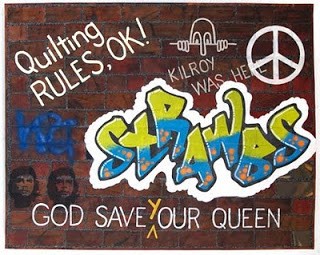Cleo Thoughts, Quilts
Messages in Fabrics: When Solitary Quilters Speak
“The monotony and solitude of a quiet life stimulates the creative mind.” -Albert Einstein
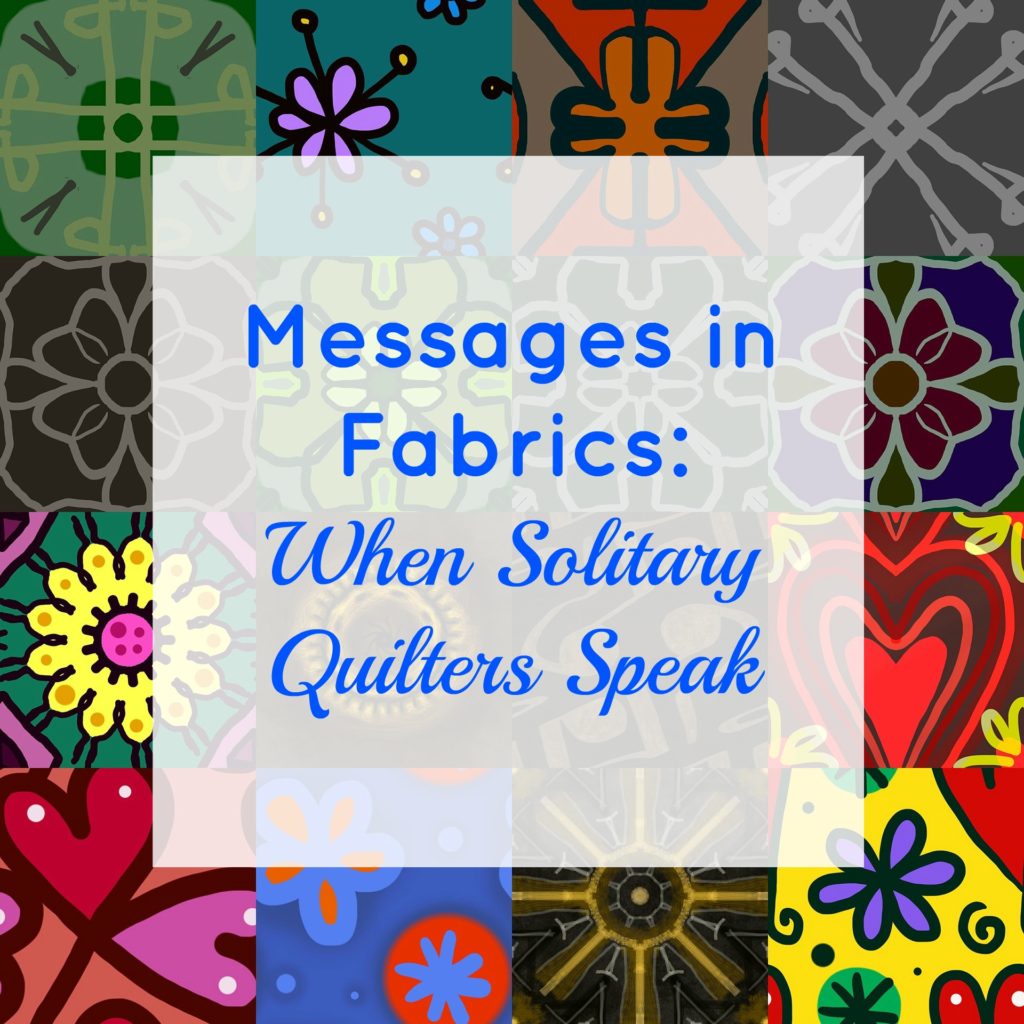
My quilting friends, Carolyn, Diane, Joyce and Jan, feel alive when the sewing machine is whirring, the pedal meets the metal, unique fabric flows between their fingers, and coffee brews nearby. Minutes melt into hours as the pieces slide over the dog feed. The aroma from the crock pot signals that hubby is due, and scraps must be organized. For these stitchers, a basement workshop is a haven. They agree with Naomi Judd when she states: “Solitude is creativity’s best friend, and solitude is refreshment for our souls.”
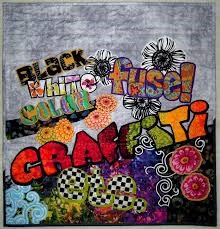
Terry Aske- “Writing on the Wall”
Whether alone or in quilting bees, most sew-ers find contentment in cloistered places, small groups or with close friends. They may not want to identify with Charlotte Bronte when they read Jane Eyre, because that character pushes the walls of protection with a challenge: “God did not give me my life to throw away.” The implication is that a person needs to “get their thoughts out there.” These are words that prod a quilter to quietly stitch messages in cloth. The deep feelings that begin in the heart and take shape in color and design. A soft communication. “It’s not about finding your voice, it’s about giving yourself permission to use your voice,” whispers Kris Carr, who presses the solitary quilter to share.
Carole Lyles Shaw believes that modern quilting is about bringing individualism and free expression to the creative process. She teaches quilting with the hope that her students will be inspired to let their “voices shine.” Shaw explains that“art quilts are ‘about something’. These quilts have meaning- and usually they are about the struggle for social justice…Activism takes many forms. Shedding light on the truth is a powerful act. Making art with meaning is an activist choice.” One of projects that she is currently working on through quilting is the importance of all citizens to speak truth to power without fear of retribution. She believes that “art is the ultimate act of hope and healing.” Her needles and thread are ready for the ideas.

Mixed media art quilt by Carole Lyles Shaw
Sometimes text helps to carry the message of the quilt. Faith Ringgold combines story quilts, painting and storytelling to bring a concept to life. “I think most people may see or may hear what I’m saying or may not. I’m not so presumptuous to feel they’re gonna get it right away…that’s why I started writing stories on my work.” Ringgold’s legacy of quilt making goes back to her great-great-great grandmother who had been a slave in her younger years, making quilts for her white masters. Her mother, a professional fashion designer, taught Ringgold to work with fabrics. Ringgold overcame deep obstacles in life to follow her dreams, but she soared with an unstoppable spirit that radiates in her written and visual works. Her motto is “If One Can Anyone Can All You Gotta Do Is Try.” Her body of work concerns serious issues of society, but she uses joyful, rich and inspiring concepts to present hope to the viewers of her quilts. Teachers use her children’s books to help students visualize their potential. Ringgold communicates a positive message for those who have suffered difficult experiences in life.
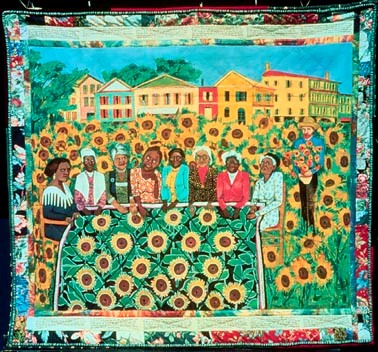
The French Collection, The Sunflower Quilting Bee, 1991, Faith Ringgold
Faith enters into the quilt making process. Terrie Hancock Mangat is a practicing Catholic who grew up with knowledge of the saints. She had the little plastic dashboard saints in her car and one day St. Christopher fell to the ground as she tried to hand him to a friend. Then she learned that some saints were not officially saints any more in the eyes of the church. She designed a quilt in memory of St. Christopher and St. Valentine who had been role models for her in her childhood at parochial school, but had been taken off the Saint Roll. “The heart is in it. It’s definitely laden with stuff outta me,” she claims of her protest quilt. “That’s the kind of work that really excites me.” Mangat is generally credited with starting the embellishment movement in quilts, but her quiet statement of church policy resonates with many.
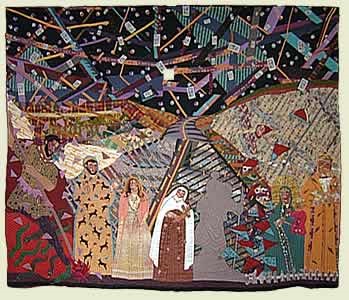
“Dashboard Saints” by Terrie Hancock Mangat , 1985
Women armed with needles become subversive stitchers, mimicking the graffiti artistically splattered on brick walls around urban areas. Combining quilting and paint, these street artists of fabric bring the message of the younger metro generation to the rest of the consciousness. One such stitcher is Terry Aske, who is not afraid of letting her quilts speak whatever is on her mind as she finds inspiration from traditional and urban stimuli. Hilary Gooding is an example of an artist whose work represents the protests of the sixties to the present with a brick wall fused and quilted by machine which is then paint sprayed. This sample of graffiti quilts brings the thoughts of those who live in the concrete jungle to a softer side of life. Who knows? Maybe the thoughts of poet Maya Angelou apply to graffiti quilt art: “If one is lucky, a solitary fantasy can totally transform one million realities.”
The message in Melissa Sobotka’s angel quilts is one of reassurance to the viewer. The folds of the fabric and the softness of the comforter wrap the broken soul in an angelic caress. Melissa’s work is created by appliqueing numerous pieces of raw edge batiks, and then enhancing them with inks for greater depth. This Texan fiber artist has a following of people who find solace from her angel quilts. Sobotka explains: “I prefer not to show faces on angels so you can focus on their power instead of their personality…In the vastness of the universe, the focus narrows to a pinpoint. This faceless angel becomes one that patiently and lovingly stands sentry guard: guiding, and watching over me.” The quilt communicates the love of a God who provides His creation with unseen visitors who give protection. A hug from angel wings.
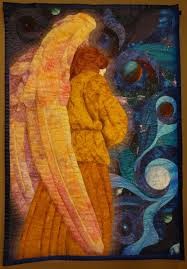
Most solitary quilters stitch because they have a deep seeded appreciation for life. Think of the topics that are regularly pieced into comforters: gardens, food, animals, fish, birds, flowers, children, trees, landscape, seascapes, ships, tractors, farms, sky/stars, geometrical designs, colorful displays and abstract ideas. The heart of the person behind the machine pushes the bobbin as life grows stressful, when grief overwhelms, or as hope rises like yeast in a bread dough. Every piece that is bound with a button hole stitch represents a silent message to the one who will cuddle in the warmth of the woolly lining. The story behind the masterpiece gives life to the voice of the one who creates it in the solitude of their sewing space.
What is the message in stitches?
“We cannot stay home all our lives, we must present ourselves to the world and we must look upon it as an adventure.” Beatrix Potter
Credits:
Main photo: https://pixabay.com/en/collage-patchwork-abstract-1717900/
Blog: Terry Aske Art Quilt Studio, “Writing on the Wall” On my design wall 2013 Terry Aske
Carole Lyles Shaw- “Mixed Media” www.carolelylesshaw.com
Images for carole lyles shaw
Artist Profile: Faith Ringgold www.ndoylefineart./com/ringgold
www.pbs.org/americaquilts/century/stories/terrie_hancock.html
Quilts: a Century of Quilts: America in Cloth. Telling Stories/PBS
Quilt: Dashboard Saints: In Memory of Saint Christopher
Graffiti Quilt-Hilary Gooding Quilts, Textiles, Art
Hilarygooding.weebly.com/graffiti-quilt.html
“Summer in the City”
“Angel Watching Over Me” by Melissa Sobotka- TheQuiltShow.com
https://thequiltshow.com/daily…/25718-angel-watching-over-me-by-melissa-sobotka

